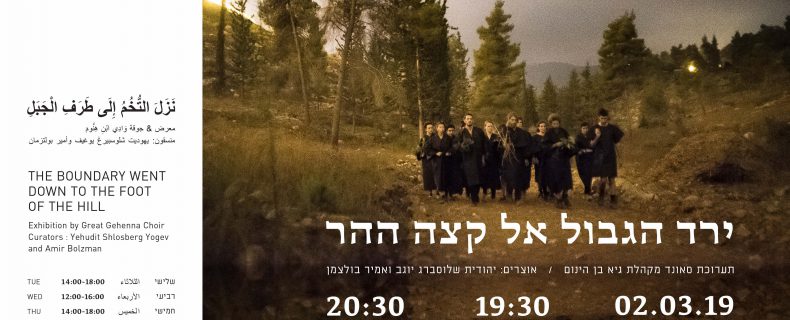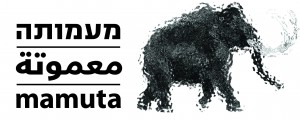The Boundary Went Down to the Foot of the Hill | Great Gehenna Choir

Opening: 2.3.2019 | Closing of the exhibition (extended!): 18.4.2019
Curators: Yehudit Shlosberg-Yogev and Amir Bolzman
In the face of the arid desert, the morbid forest, the bands of demons, the scapegoats, the tigers rising on full moon nights,we must gather, sing, shout together, wake the one that dwells within us, which is as deep as the depth of an abyss and as wide as the width of the sky; The one we have shrunk, repressed, forgotten.
The Great Gehenna Choir is a choir whose members – singers, composers, conductors and multidisciplinary artists – work and create in full partnership. The sequences of songs they perform – hypnotic, humorous and sweeping – were written and composed specifically for them. Around these songs, the choir’s relations, with itself and with the audience, form a sort of tribal gathering – public, contemporary rituals, aimed at extracting ancient symbols in the common subconscious through the gates of ecstasy to a new vitality.
In his dreams, Carl Gustav Jung describes, the modern man as still being inclined to the infiltration of primitive religious symbols, forms, and images, but the retraction of rites of passage in Western culture leaves him without a mythical context to give them meaning.
Through language, body, voice and intention, the Gehenna Choir seeks to experience magical action, to reexamine the power of the ritual, to mould the transformative potential of music itself, enabling the reorganization of associations, memories and dreams within contemporary cultural space.
The Great Gehenna Choir was born following an initiative of the Mamuta Center, which invited musician Noam Enbar to set up an experimental communal choir. Enbar gathered a group of singers, as well as poet and playwright Yonatan Levy, who writes the lyrics for most of the choir’s songs. Since then, over the last four years, the choir members meet every week at Mamuta / Hansen House. They compose, perform, manage and produce the performances as a collective, constantly exchanging roles.
The character of the conductor in the classical choir, who is entrusted with the interpretation of the written work, is replaced by the entire group; The central-hierarchical function of conducting has been left behind, in favour of concentration, will, attention and interpretation of the body of the group itself. Thus, the choir, in an ongoing process and in a constant investigation, presents a collaborative structure that gradually detaches itself from power structures, creating a process work model in which the “product” is never completed.
In the exhibition “The Boundary Went Down to the Foot of the Hill” we chose to spread the voice of the choir over space and time. The spaces of Mamuta, which in the early years of the choir formed the basis and home for its rehearsals, now serve as exhibition spaces for their unique work process. Within the exhibition, we sought to penetrate the “performance” and the “completed work” parting it into the components of the organism, to reveal the details and sounds that operate within it, and the mechanisms of study and work that motivate it. This is a research with ethnographic characteristics, and is based on viewing a group that has multiple approaches and modes of creation that exist side by side in parallel. As curators, we met the choir, observed the rehearsals, extracted material and recorded each member in a short interview.
The first two spaces in the exhibition are “study rooms”. The modes of study and components of the experience are presented through the work of five members of the choir – Amir Meir, Laila Betterman, Gidon Levy, Natan Skop and Ido Akov – and through our works, curators Amir Bolzman and Yehudit Shlosberg-Yogev. On the “study table”, an assortment of exercises extracted from rehearsals; physical loudspeakers, sketches of scores, mechanisms that activate basic rhythms and conversations with the choir members. In the “study rooms,” the performance breaks down from its entirety, and the viewer moves from listening, to actively participating in learning the material.
The listener’s involvement is the basis for Faye Shapiro’s work, “Keep on singing in order to hear” This work invites the audience to stand as a single body in front of the choir; to make a sound, sing, play and explore, through one’s own voice, the possibilities of hearing another voice.
In the cinema room, we exhibit the piece “Blindsight,” created for “Mekudeshet” Festival 2018 by Noam Enbar, in collaboration with Yonatan Levy (texts), Nir Shauloff (dramaturge) and choir members. The performance was executed for the first time in the Jerusalem Forest, as a multi-participant ceremony for a blindfolded audience. The performance is made up of a cycle of songs that use the space as a composing-experiential tool: distant shouts, close whispers, howls and deathly sounds – these become listening tools for the audience, whose eyes are shut. In the exhibition, the piece has been re-edited to a quadraphonic sound system, and the practice of listening is within a closed space. The quadraphonic placing of the sound preserves the original movement between the forest trees, and re-positions the piece in the gallery space, giving the experience a new interpretation.
Members of the Choir: Noam Ahdut / Ido Akov / Laila Betterman / Ella Daniel / Ruth Danon / Noam Enbar / Amit Fishbein / Katrin Lasko / Gidon Levy / Dor Magen / Amir Meir / Tamara Nishri / Ellie Orian / Natan Skop / Elana Snitman / Faye Shapiro / Michal Tamari /
Artistic Management of the Choir: Amir Meir, Gideon Levy, Laila Beterman, Noam Ahdut, Faye Shapiro | Choir Production: Amit Fishbein
Mamuta Art and Research Center
Directors: Sala-Manca Group
Project Management & Administration: Shahar Ben-Nun | Technical Advisor & Exhibitions: Yoav Fisch | Sound Consultant: Amir Bolzman | Office & Production: Tamar Drozd


